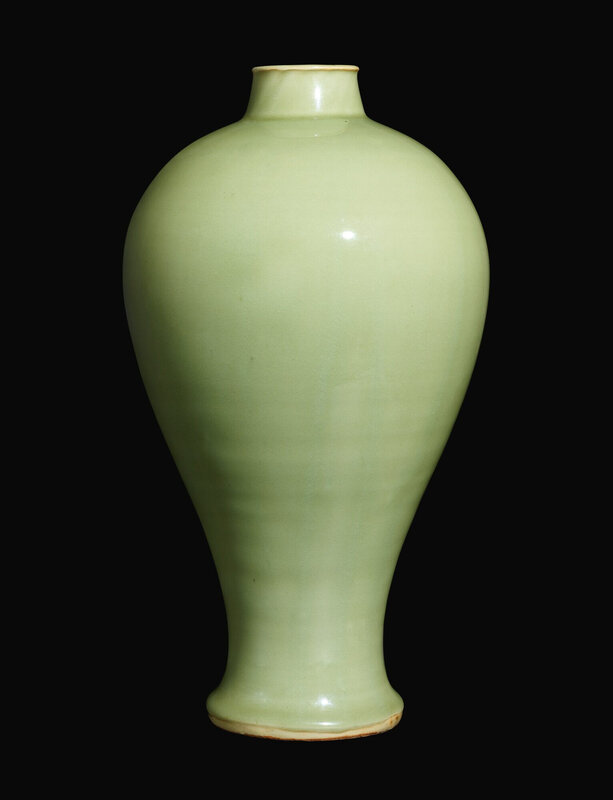An exceptional and large Longquan celadon vase, meiping, Early Ming dynasty

Lot 105. An exceptional and large Longquan celadon vase, meiping, Early Ming dynasty; 38.8 cm, 15 1/4 in. Estimate 4,000,000 — 6,000,000 HKD. Lot sold 7,375,000 HKD. Courtesy Sotheby's.
superbly potted with broad rounded shoulders elegantly rising at a flared angle from the slightly splayed base and sweeping to a tapered neck and a lipped mouth, the voluptuous body thickly applied overall with an unctuous sea-green glaze save for the unglazed footring burnt brownish-orange during the firing, Japanese wood box.
Note: Deceptively simple in form and design, yet with its dynamic silhouette and near-flawless glaze, this vase ranks amongst the finest examples of Longquan celadon wares, making it eligible for the imperial Ming court. It embodies the technical perfection achieved by the Longquan craftsmen as such undecorated vessels required the highest level of skill and precision in every stage of their production. Markedly top-heavy with a relatively narrow-waisted foot, this vase is a result of careful calculation: the exact proportions and firing temperature had to be achieved in order to prevent sagging or collapsing. The slightest irregularity in the clay, potting, glaze or firing would result in the destruction of the piece.
A slightly taller Longquan meiping from the Qing court collection, is preserved in the Palace Museum, Beijing, together with its original cover; see Longquan of the World: Longquan Celadon and Globalization, vol. II: State Vessels, Beijing, 2019, cat. no. 94. The author suggests that judging from its elegant shape, the Beijing example was probably made according to the authorised design for the Yongle court (p. 156). Four similar vases in the National Palace Museum, Taipei are included in the Museum’s exhibition Green. Longquan Celadon of the Ming Dynasty, Taipei, 2009, cat. nos 64-67. Another example of this form and size in the Tokyo National Museum, formerly in the Yokogawa collection, is published in the Illustrated Catalogue of Tokyo National Museum. Chinese Ceramics, vol. 2, Tokyo, 1990, pl. 486. Two further vases were sold in our London rooms, one 20th May 1986, lot 2, the other, 10th November 2004, lot 561. Kiln wasters of many related vases and matching covers have been excavated from the imperial Longquan kilns at Chuzhou, Zhejiang province; see Ye Yingting and Hua Yunong, Faxian: Da Ming Chuzhou Longquan quanyao [Discover: Imperial ware of the great Ming dynasty from Longquan in Chuzhou], Hangzhou, 2005, pp. 38-101.
The form of this vase is an exaggerated version of the characteristic meiping of the Longquan kilns of the early Ming period and appears to derive from similar large blue and white prototypes from the imperial kilns at Jingdezhen; compare six meiping, decorated with various banded designs, excavated from the Yuan dynasty hoard at Gao’an country, illustrated in The Porcelain from the Cellar of the Yuan Dynasty in Gao’an, Shanghai, 2005, pp. 52-63. Longquan vases of this type were also decorated with scenes closely related to motifs developed at the Jingdezhen kilns; for example see a covered meiping carved with bamboo and prunus, in the Palace Museum, Beijing, published in Longquan of the World, op.cit., cat. no. 95. Such similarities support the notion that the court in Beijing commissioned and sent designs to Longquan kilns to be recreated for imperial use. Official documents record that the Longquan kilns were producing wares for the court until at least the Chenghua reign.
Sotheby's. Monochrome, Hong Kong, 11 July 2020

/https%3A%2F%2Fprofilepics.canalblog.com%2Fprofilepics%2F1%2F0%2F100183.jpg)
/https%3A%2F%2Fstorage.canalblog.com%2F03%2F02%2F119589%2F96711876_o.jpg)
/https%3A%2F%2Fstorage.canalblog.com%2F11%2F31%2F119589%2F94773502_o.jpg)
/https%3A%2F%2Fstorage.canalblog.com%2F20%2F83%2F119589%2F94772815_o.jpg)
/https%3A%2F%2Fstorage.canalblog.com%2F26%2F72%2F119589%2F75604929_o.jpg)
/https%3A%2F%2Fstorage.canalblog.com%2F59%2F60%2F119589%2F26458628_o.jpg)




/image%2F1371349%2F20240329%2Fob_17ee91_115-1.jpg)
/image%2F1371349%2F20240323%2Fob_65a2da_434238029-1637329100370436-25280776982.jpg)
/http%3A%2F%2Fstorage.canalblog.com%2F69%2F46%2F119589%2F129423593_o.jpg)
/http%3A%2F%2Fstorage.canalblog.com%2F63%2F90%2F119589%2F129042528_o.png)